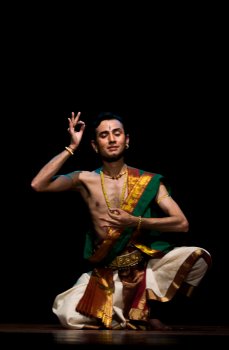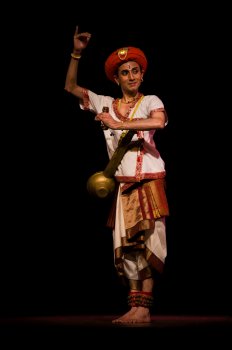
|   |

|   |
Journeys of the soul - Veejay Sai, Bangalore e-mail: vs.veejaysai@gmail.com Pics: Santosh Bankapur February 8, 2013 Where does a sense of belonging come to a geographic location? Can something as a dry and bland town be a subject of artistic inquisitiveness? Why not! Every holy city in India speaks to its seeker and to the visiting pilgrim. As the famous writer Raja Rao mentions in his magnum opus ‘The Serpent and the Rope’, India is not a geographical or historical entity but more of a philosophical concept and a symbol of spiritual calling. “India is not a country, it is a perspective,” he says speaking about how every location is dotted with a rich history, mythology and folklore. Each and every village and town in the country has its own story to tell. ‘Sthala puranas’ are a genre of writing on their own. The English language has almost no word equivalent to describe the depth of what these stories mean and how they get interpreted time and again. On the last day of the famous Kinkini festival, Bangalore’s very own Praveen Kumar presented ‘Pandharpur,’ a choreographic work on the famous holy town in Maharashtra. While knowing the tale and myth is one side of the story, adapting it and putting together a dance presentation is yet another challenge.  As the program began with everyone’s favourite Marathi song to Lord Ganesha, ‘Prathama tula vanditho’ made famous in the movie ’Ashtavinayak’ through the voice of Pandit Vasantrao Deshpande and Anuradha Poudwal, the audience got a first glimpse of a silhouette of Lord Vitthala, crown, fish-ear ornaments and a garland of roses around his neck intact, in the dim lights amidst chants. Cut to! One has to say ‘cut to’ because of the abrupt cut in the narrative that kept repeating itself through the course of the presentation almost like three scenes juxtaposed. Opening with Adi Shankara’s famous ‘Pandurangashtakam,’ Praveen’s abhinayam was fresh and innovative. Every time a stanza ended with ‘Parabrahma lingam bhaje Pandurangam’, the performance increased in its intensity. Describing the physical beauty of Lord Vitthala in the lines ‘Lasath kundalaaakrantha gandasthalaangam, Japaraga bimbadharam kanja nethram,’ one could see Praveen shine forth with bhakthi. While Kaushik Aithal is certainly one of the better of youngsters we have among Hindustani vocalists in Bangalore, he seemed clueless on the pauses he needed to take and to sing for dance. The second part of the presentation dealt with the story of Saint Namdev. Praveen returned with a Maharashtrian turban adorning his head and a tambura around his waist, singing ‘Panduranga Vitthala Pandharinatha Vittlaha’. With the Kartal in his hands, he had the audience swinging to the tune and took them along with him on his pilgrimage. Along the way we see the idols of Lord Ganesha, Hanuman and the whole devotional procession. Narrating the story of Saint Namadev, Praveen’s choreography, though a bit hurried, was a delight to watch. Using smart techniques to show the darji Damashet’s day-to-day tailoring business and his longing for a child, the choreography was noteworthy. A bit rushed in the dream sequence, which could have been done with more crispness, Praveen danced to the melodious Abhangs ‘Sundara the dhyaana’ and ‘Pandharicha vaasa chandrabhaga snaana’ in the following scene. For rasikas who are fans of old-world Marathi Abhangs, this production turned out to be a good time to revisit some of their favourite numbers.  In the last part of the production, Praveen paid homage to the presiding deity of the town. Though Pandharpur is well known for the temple of Lord Vitthala, the presiding deity of the place is Lord Shiva. The Jain author Hemachandra who lived between 1089- 1172 AD, notes that the epithet of Lord Vitthala actually has a Shaivite history. The saints of the Varkari tradition celebrate both Shiva and Vishnu. Praveen narrated the story of Saint Narahari Sonar, a non-compromising staunch Shaivite who lived close to the Vitthala temple but never visits the temple as he feels he has nothing to do with Lord Vitthala or his devotees. On getting orders for making a gold waist-band for Lord Vitthala, Narahari refuses the offer outright saying he cannot measure the statue and would never enter the temple to do so. The devotee who gives him the order agrees to bring the measurements and accordingly Narahari makes the waist-band which turns out to be tight for the statue on the day of adornment. The desperate devotee returns to Narahari with a request to repair the ornament. Narahari who needed the exact measurements agrees on the condition that he would repair, if he was allowed to measure the statue blindfolded. The blindfolded Narahari heads to the temple sanctum to measure Vitthala’s waist and begin his work. He gets curious as he goes about his work when he feels the statue adorned with animal skin. On groping he realizes his hands feeling the antelope, axe, trishulam, damaru and all of Shiva’s paraphernalia. He even feels the rudraksha mala around his neck, crescent moon on his matted locks and the Ganges on his head, his third eye on his forehead and snakes over his body. His increasing suspicion and anxiety lead him to remove his blindfold with great expectancy but he is utterly disappointed to see Lord Vishnu instead of Lord Shiva. After several attempts, Narahari realizes it is the leela of god making him realize that Shiva and Vishnu were one. Praveen’s acting in these sequences was outstanding. Alternating his act between facing his back to the audience as Lord Vitthala standing arms akimbo and facing front as the blindfolded Narahari, Praveen lent the right amount of theatricality to the series of events unfolding to the backdrop of Abhang music. However, in the production, there was a striking absence of Goddess Rukmini or Rakhumayi as she is known in Pandharpur. What is Lord Vitthala without his beautiful consort and better half? If Praveen can rework this a bit with a good set of musicians and a stronger narrative to hold on to, this could be one of the finest productions ever performed by a solo dancer on a rather difficult theme like this. It is certainly one of the more original ideas created by any dancer and deserves to tour across sabhas and festivals. Veejay Sai is a writer, editor and culture critic. |